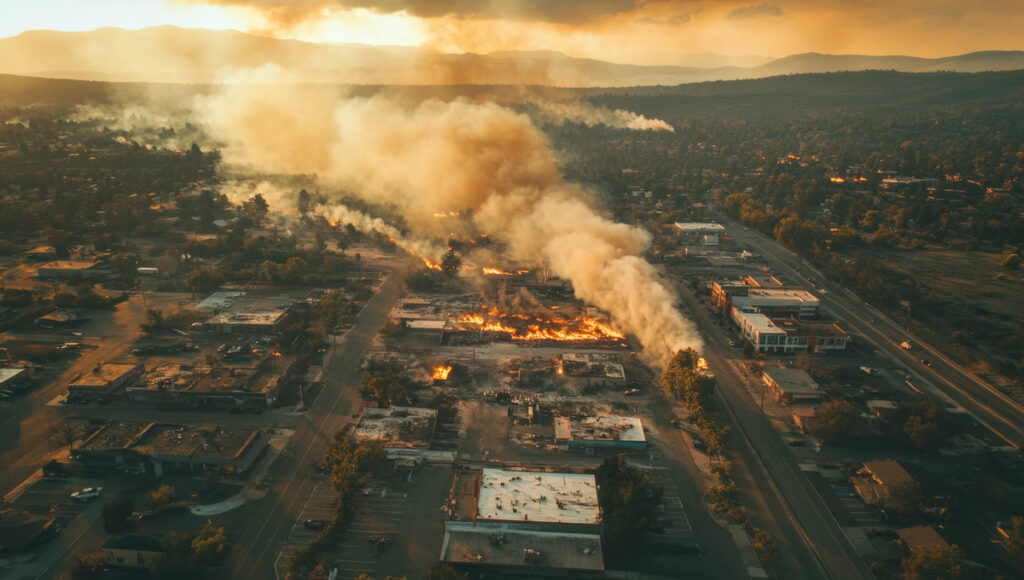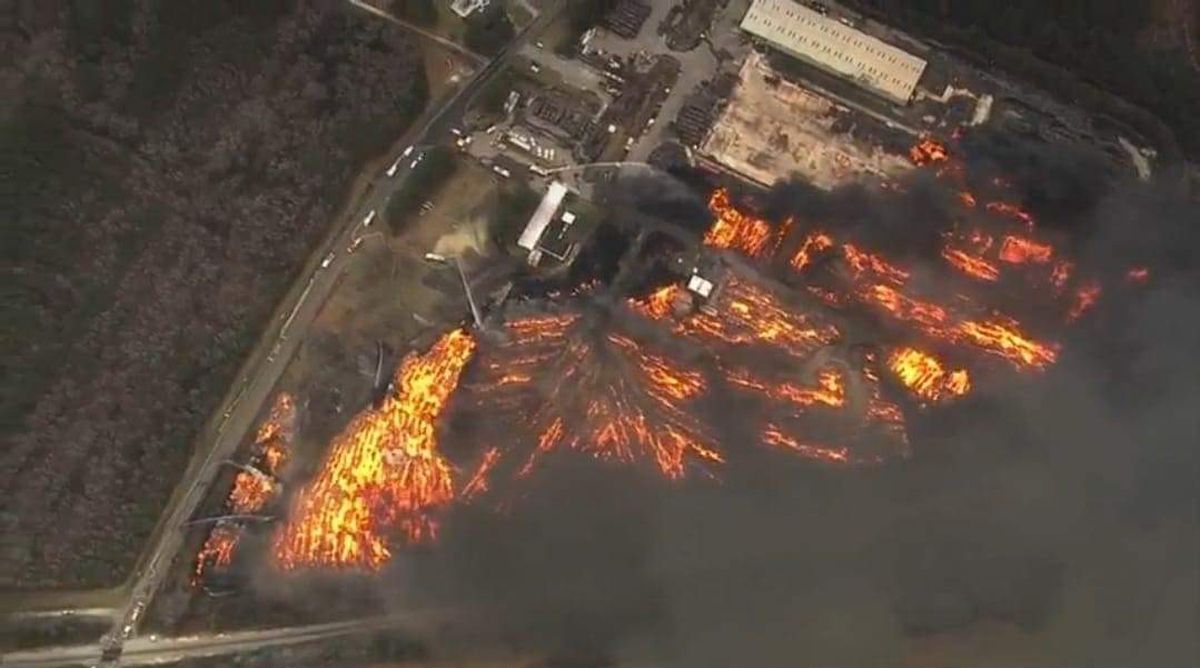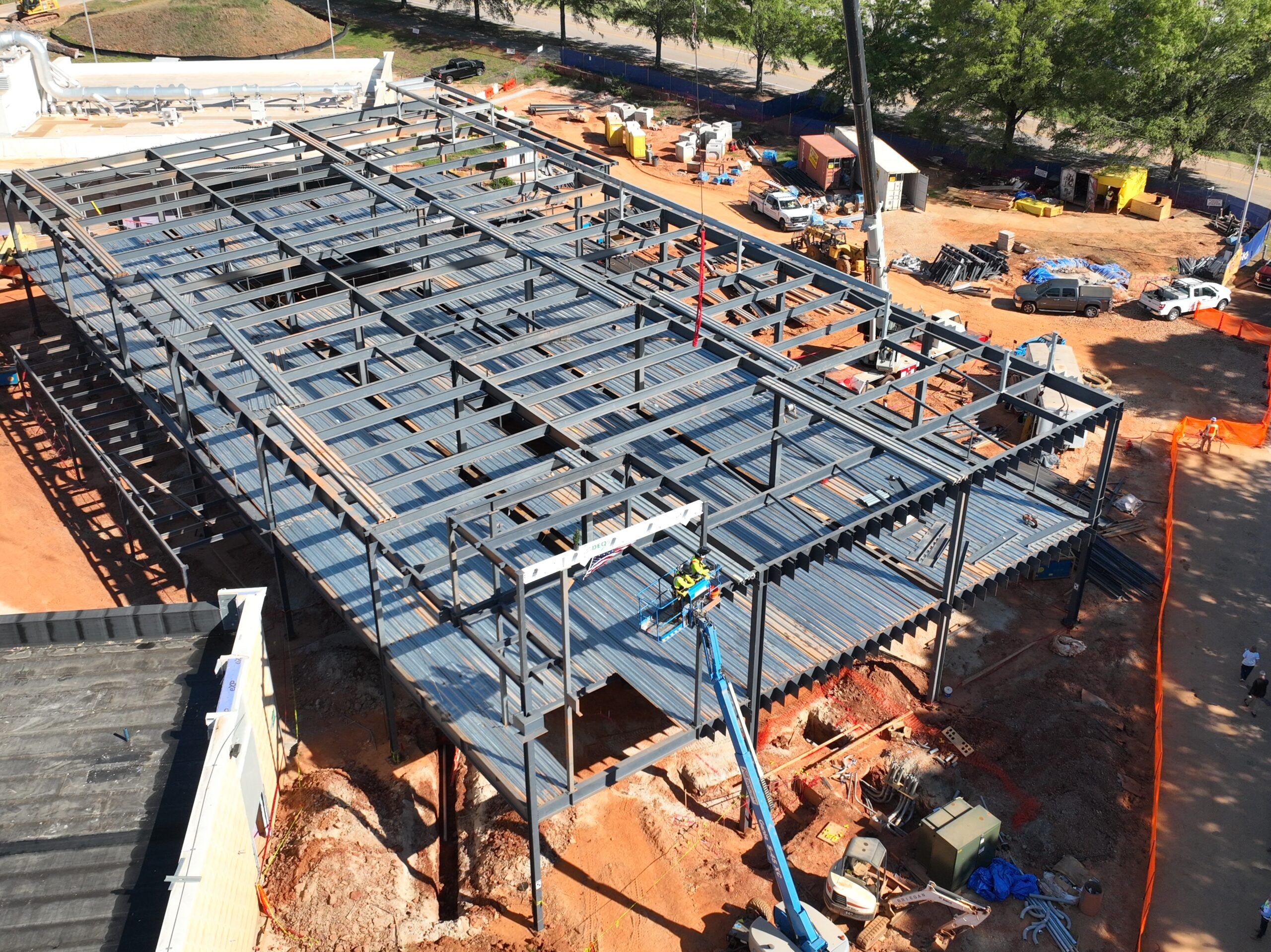A major fire event can be one of the greatest threats to your operational security, with the potential to massively disrupt your business and endanger the lives of workers. One area commercial facility owners and managers may be overlooking: their roofs.
Commercial and industrial fires can be catastrophic events that cost millions of dollars, cause operational downtime, and even result in loss of life. Warehouses, manufacturing facilities, data centers, schools, hospitals, restaurants, and more, all face significant risk from major fire events, and mitigating that threat should be a priority for building owners and operators.
Consider these statistics from the National Fire Protection Association (NFPA):
- From 2017–2021, U.S. fire departments responded to an estimated annual average of 36,784 fires at industrial or manufacturing properties. The annual losses from these fires included 22 deaths, 211 injuries, and $1.5 billion in direct property damage. (Fire in Industrial or Manufacturing Properties, Sept. 3, 2023)
- Fire departments responded to an estimated annual average of 1,508 structure fires at warehouse properties in the U.S. from 2018 to 2022. These fires caused an average of three civilian deaths, 19 civilian injuries, and $323 million in direct property damage. (Warehouse Structure Fires Report, Feb. 1, 2025)
With these facts in mind, it is worth exploring one often overlooked area of the building envelope that can contribute significantly to—or prevent—the spread of flames in a fire: the roof.
Here, we will examine common causes of rooftop fires, different roofing materials from the perspective of fire safety, as well as how to make the right choice for your facility.
 Common Sources of Rooftop Fires
Common Sources of Rooftop Fires
Facility fires can originate from various sources, but commercial roofs are an increasingly concerning area of risk. Today’s commercial rooftops are platforms for many types of equipment, operations, and electrical infrastructure, all of which have the potential to start or fuel a fire.
In addition, external sources are an ongoing threat that building operators likely have little to no control over preventing possible fire sources (See sidebar, “5 Fire Sources to Keep on Your Radar”).
While interior building fires may pose a more immediate threat to occupants, a rooftop fire comes with its own unique threats. For example, because commercial roofs typically lack fire detection mechanisms, rooftop fires may go unnoticed until they have already spread significantly.
This delay in detection can increase the severity of the fire. Additionally, rooftops are not equipped with automatic sprinkler systems, allowing flames to grow unchecked. Wind can further accelerate the spread of fire across the roof’s surface, often more rapidly than an interior fire.
Once underway, rooftop fires pose serious challenges for emergency responders, as firefighters must access the roof by climbing the structure, increasing both difficulty and danger. In severe cases, the rapid spread of flames can compromise structural integrity, potentially leading to collapse.
For all of these reasons, fire performance should be a primary consideration for building owners when selecting their roof systems.
Evaluating the Fire Performance of Your Roof
The ASTM E108 or UL 790 test methods are widely accepted in the United States to classify roof systems based on their performance under fire conditions originating outside the building.
These tests are specified by the International Building Code (IBC), which most jurisdictions throughout the country have adopted. The standards include three primary fire tests, including:
- Intermittent Flame test – This test evaluates the resistance of the roof covering when exposed to intermittent fire conditions. It is required if the roof is installed on a combustible deck.
Spread of Flame Test – This test simulates burning embers landing on the roof. This test is required for both combustible and noncombustible deck types.
Burning Brand – Used to determine a roof’s ability to resist ignition, fire spread and burn-through by placing wood on the surface of the roof covering. This test is required if it is to be used on a combustible deck.
Depending on the material’s performance, it is then classified into one of three types according to the ASTM E108 or UL 790 test standards:
- Class A is the highest fire-resistance rating, and is often an architectural requirement for buildings that may be more at risk for fires or by local building codes in areas prone to high wildfire risk. Class A Tests are applicable to roof coverings that are expected to be effective against severe fire exposure, afford a high degree of fire protection to the roof deck, do not slip from position and are not expected to present a flying brand hazard.
- Class B designates a roof that withstands moderate exposure to fire and resists flame spread of 8 feet or less. Class B tests are applicable to roof coverings that are expected to be effective against moderate fire exposure, afford a moderate degree of fire protection to the roof deck, do not slip from position and are not expected to present a flying brand hazard.
- Class C designates a material that resists flame spread of 13 feet or less, and offers limited protection against fire. Class C Tests are applicable to roof coverings that are effective against light fire exposure, afford a light degree of fire protection to the roof deck, do not slip from position and are not expected to present a flying brand hazard.
 Real-World Performance
Real-World Performance
While it is understandable to assume that a Class A fire rating represents the highest level of protection available, this inference does not tell the whole story.
The roof system as tested for flame resistance includes several different materials that make up the roof, such as membrane, insulation, fasteners and other potential components. The overall results are dependent on how those materials perform when assembled just as they would be on a roof.
And even with a Class A rating, there is no requirement that the system not burn, only that it burns slowly enough to limit flame spread within a desired distance during the duration of the test.
Consider that single-ply roof membranes are commonly used within commercial roof systems and made from thermoplastic polyolefin (TPO), ethylene propylene diene monomer (EPDM) or polyvinyl chloride (PVC). But different single-ply membrane types on their own may contribute to flame spread more than others.
For example, independent testing has shown that TPO membranes can contribute to significant flame spread on the roof, increasing the risks and consequences related to a rooftop fire.
And according to the NFPA 701 vertical burn test, one TPO specimen, approximately 5 inches wide x 48 inches tall, exhibited melting and dripping behavior while burning more than 38 minutes before fully consuming the fuel contained within the sample itself.
Comparatively, high-performance roof membranes that have demonstrated self-extinguishing properties can minimize flame spread and roof fire severity, contributing to overall operational security and safety. A roof membrane has the ability to either contribute to or halt the spread of flame in the event of a real fire.
While some materials can enhance or limit a roof’s ability to support ignition and flame spread, the proper design, construction and installation are equally important to minimizing risk. By working with reputable suppliers and contractors when considering a new roof system for a facility, building owners can gain peace of mind that they’re making the best decisions for their buildings.
Seek professionals who understand how to design for and mitigate fire risks and have experience working with high-performance roof systems. Installations should also include in-process inspections to identify any potential errors, specifically those that may contribute to increased fire risk.
Fire performance often goes overlooked as a primary risk associated with commercial roof systems, and Class A-rated systems may provide a false sense of security when it comes to real-world performance. For building owners and operators, due diligence is key when selecting and specifying roof systems.
Choosing the right roof membrane and system design can make a significant difference in keeping the facility, its assets and its occupants safe.
Ryan Van Wert is the Technical Services Manager for FiberTite Roof Systems at Seaman Corporation. He has been in the commercial roofing industry since 2017, following a career in structural design. He holds a Master of Civil Engineering, Structural Engineering, from Norwich University and a bachelor’s degree in Construction Management. Since 2006, Ryan has accumulated extensive experience in the construction industry, including building inspections, mold inspections, and energy audits, bringing a broad range of technical expertise to his role.
5 Fire Sources to Keep on Your Radar
1. Exhaust systems
Within commercial and industrial facilities, exhaust units are one area of risk. These exhaust systems rely on duct materials that penetrate the roof system, and operational failure has the potential to lead to a fire. Additionally, these systems sometimes expel contaminants onto the roof—commercial kitchen exhaust, for example, may contain animal fats or greases, which can increase the risk of spread in the event of a fire.
2. Electrical systems
A commercial roof is home to many operations that depend on electricity. From HVAC units to rooftop solar panels, the likelihood of a rooftop fire increases with any electrical breakdown—including arc faults, ground faults and short circuits—that can occur across these systems.
3. Weather events
Sometimes Mother Nature strikes without warning, and severe weather events have the potential to not just damage your roof, but lead to a fire. Lightning during a thunderstorm is just one example. Wildfires are another concern in at-risk areas of the country; even if a building is not in immediate danger from wildfire spread, wafting embers may land on the rooftop and cause damage.
4. Maintenance and repair
Rooftop systems require routine maintenance that can sometimes introduce fire risk. Arc welding, for example, may introduce molten metal and sparks. Errant smoking and discarded cigarette butts may pose additional risks. Additionally, in new construction applications, many other trades perform work on adjacent surfaces and systems as the roof is installed.
5. Debris buildup
While not a source of ignition on its own, excessive debris buildup, like dead leaves on a rooftop, can become fuel for a burgeoning rooftop fire.












